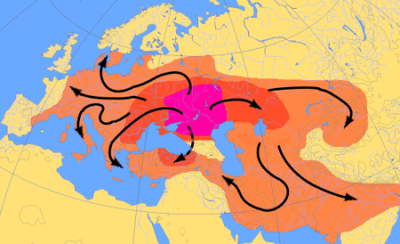The Horse, the Wheel and Language
The Horse, the Wheel, and Language: How Bronze-Age Riders from the Eurasian Steppes Shaped the Modern World (ISBN 0-691-05887-3) is a 2007 book by David W. Anthony, which won the Society for American Archaeology's 2010 Book Award.[1]

The book explores the origins of Indo-European languages (now spoken by three billion people) in the context of the domestication of the horse and invention of the wheel in the Eurasian Grass-Steppe of the temperate grasslands, savannas, and shrublands. The relevant archaeological evidence for the early origins and spread of the Indo-European languages is examined, giving support to a version of the Kurgan hypothesis. A key insight is that early expansions of the area in which Indo-European was spoken were often due to "recruitment", rather than due only to military invasions. With the Yamna culture as a nucleus candidate, the original recruitment would be to a way of life in which intensive use of horses allowed herd animals to be pastured in areas of the Ukrainian / South Russian steppe outside of river valleys. According to Anthony's researches, the earliest effective domestication of horses occurred in approximately the same period and geographical area where the Indo-European languages started to spread. The splitting off of the major branches of Indo-European (except perhaps Greek) can be correlated with archaeological cultures showing steppe influences, in a way that makes sense chronologically and geographically in light of linguistic reconstructions.
References
External links
- Sample chapter
- New York Times review
- Dreamflesh Review
- Entry at Google Books
- Entry at AbeBooks
- 'Horseback Riding and Bronze Age Pastoralism in the Eurasian Steppes', David W. Anthony, University of Pennsylvania Museum, YouTube (video)